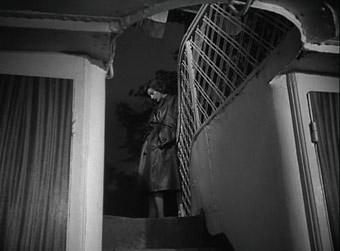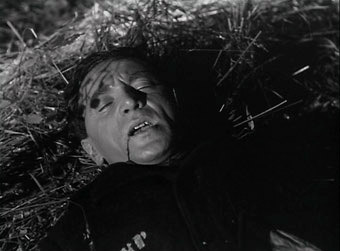|
A rebellious young biker, Francois Gerane, frantically tries to get money together to pay back a debt to a local villain. In his desperation he breaks into his lawyer father's house, steals a wad of notes and burns some important legal documents out of spite. His father catches him in the act, provokes his son into hitting him and then commits him to a mental hospital in order to iron out the young man's behaviour. Once inside, the motorcross star tries to bust out several times and falls in love with his only visitor Stephanie. In between the escape attempts he is treated first by Dr Varmont, a conservative who sees himself as a protector of society from the mentally ill, rather than a carer for the mentally ill; and Dr Emery, a radical psychiatrist who tries to engage with his patients on a personal level and encourage them to regain their personal freedoms.

If all this sounds a little hackneyed and predicable to modern viewers, La tête contre les murs actually ends up feeling surprisingly even-handed and fresh. In the extras, star and screenwriter Jean-Pierre Mocky claims that this was the first French film to deal seriously with mental illness, and a pre-credits pre-amble states that the admirably lofty goal of the picture is to 'transform the way the mentally ill are treated'. Certainly there is a touch of the stereotypical institution-versus-individual structure here that we have seen in many stories about psychiatric care hence (Changeling ticks most of the boxes in its asylum scenes), but Mocky and director Georges Franju soften the edges somewhat to create a more nuanced piece. Sure, Francois is a rebel – speeding down country lanes, visiting beatnik hangouts and copping off with gangster's molls – but as Dr Vermont points out, Francois is 25 – just ever so slightly too old to be impetuously burning his father's documents and breaking into his parents' house. Its made clear from the very first shot of the film that Francois' rebellion is futile. The opening shot sees him tearing across a patch of French countryside on his motorbike, weaving up and down hills and skidding about the landscape. Franju's camera keeps the boy trapped in long-shot, following his every move in an extremely long take that effectively traps him in the camera frame. The camera moves first and Francois follows, and what few cuts there are occur before Francois has left the frame. He can't escape the scrutiny of the camera, foreshadowing the intense examination to which he is later subjected by the hospital – even in his moment of freedom, he is a prisoner. His later escape attempts are shot in much the same way – Francois can never escape the camera, dulling his outlaw edge. It probably doesn't help that Mocky's performance emphasizes the character's victimization and naivety rather than any dissident spirit. The haunted look in Mocky's eyes, together with downbeat line delivery play up Francois' emotional scars very effectively.
The film's two doctors, representing two approaches to psychiatric care, are both well-rounded characters who are given plenty of room to articulate their philosophies on how care for the mentally ill should work. Its a tribute to the Mocky's script that the reactionary doctor Varmont isn't portrayed as a one-dimensional demagogue. Although he freely admits his first duty of care is to society – making sure the patients don't escape and cause harm – he resents the burden of administration as much as those he oversees. He repeatedly tells people that he's not interested in punishing his patients for the crimes they may have committed, but equally is wary of his patients' criminal tendencies and has no time for the more hands-on approach of Dr Emery; when the two men talk together about their respective attitudes and techniques for psychiatric care, Varmont makes perfectly reasonable arguments for the established methods. Opposed to him is Dr Emery, a character who could easily fall into the Patch Adams mold but instead, like Varmont, is represented in more complex terms – allowing his patients freedom of expression on the one hand and apparently pioneering a softly-softly attitude towards them, but at the same time being shown as someone who only deals with certain cases and evidently enjoys the publicity his unorthodoxy brings.

This examination of psychiatric procedures – the split between progressive and conservative – is the keystone of the film. In one scene, the two doctors debate the issues face to face, walking around an aviary cage filled with Franju's trademark doves. Even though the dialogue is a bit too expository (the inclusion of statistics in film speech is always a suspect move), the issues are articulated well and concisely. It helps here that the universe in which the film is set is offbeat, and at times surreal. Franju has filled his filmic world with incongruous detail and bizarre locations that help to salve some of the screenplay's campaigning. In a visually arresting scene at the opening of the film, Stephanie and Francois visit a bar located on a docked boat, apparently in the middle of the countryside. As they arrive, a girl swims up to the boat out of nowhere and climbs aboard deck, berating Francois for not calling her. No-one bats an eyelid. As Francois leaves a gambling den in the city, a dog slinks out behind him and runs off into the night – its not siginificant, but it fills out the universe. Likewise during one of Francois' escapes, he flees the asylum across a field that is on fire – again for no reason, but its inclusion adds an extra layer to the shot that gives the film a dream-like and complete quality. This quality is enhanced infinitely by the sublime photography of Eugen Schüfftan, alumnus of Abel Gance's Napoleon and Fritz Lang's Metropolis, who shoots with an eye to the bleak and oppressive, and presents some astonishing tricks of light (look for the climaxing moment on a staircase at the conclusion of the film – unforgettable). Similarly, Maurice Jarre's fractured and ominous jazz score aids the film's nightmarish qualities enormously.
La tête contre les murs is a stylish, surreal and confident film that is a fair more emphatic treatise on mental health and psychiatry than most other films that deal with the same subject matter. The numerous shades of grey – both narratively and visually – are more than welcome.
Framed in its original 1.33:1 aspect ratio, this is a typically fine transfer from Eureka's Masters of Cinema strand, a clean and stable monochrome picture with only the occasional small scratch still visible. Contrast has been carefully judged here, with the blacks giving way to deep grey in some of the interior shots but in a manner that feels right for the scenes, while a fuller range is visible on the daytime exteriors. There's no enhanced harshness here to boost the blacks, resulting in a well balanced image that retains its shadow detail. Sharpness is good if a little shy of reference quality – some areas of more complex detail like grass, brickwoork or facial close-ups are particularly good.

The Dolby 2.0 mono soundtrack is largely clear of damage, save for the odd small pop. The dynamic range is unsurprisingly restricted, with the trebles in particular sounding a little clipped. There's a faint hiss in the background, but you'd need to have the volume cranked up to really be bothered by it.
The original trailer (1:55) markets the film as an escape thriller, 'a battle for freedom and love'.
There is an interview with Jean-Pierre Mocky (09:35) that ostensibly introduces the film, and also allows Mocky to talk about the making of the film. He wrote the script, picked the locations, hired the cast and even directed a couple of scenes while Franju was ill, and ven takes credit for Charles Aznavour's Etoile de Cristal acting award. He does graciously concedes that the film is probably '80%' Georges Franju however.
A second interview between Mocky and Aznavour (04:44) only touches briefly on La tête, and also includes the rather outlandish (but possibly true) claim from Mocky that the film is shown at psychiatry conferences across the world and that there 'are no more films about the insane'. Err...
For fans of Georges Franju, or for those who enjoy genuinely offbeat, haunting cinematic visions, this is a worthwhile purchase. It leaves a lasting impression, and is well serviced by this Eureka release.
|